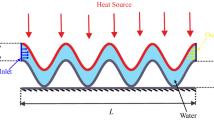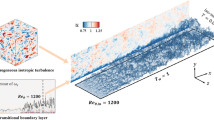Abstract
The article presents the results of numerical simulation of the boundary layer of air on a heated surface in the presence of weak acceleration. The numerical model consists of a system of Prandtl equations, describing dynamic and thermal processes in the boundary layer, and a k-ω-γ turbulence model that allows reasonably simulating the laminar-turbulent transition and turbulence suppression. Finite-difference methods were used to solve differential equations. For some calculated cases, the turbulence model was switched off in order to obtain parameters of a known laminar flow. Modeling has shown that under the considered flow conditions, the occurrence and development of a local laminarized region is possible in the vicinity of the wall. In this case, the boundary layer includes the near-wall laminar and external turbulent sections. This nature of the flow leads to a level of friction and heat transfer that correspond to the intermediate flow relative to laminar and turbulent flows under the same conditions.
Similar content being viewed by others
References
M.E. Deich, A.A. Koh, A.V. Robozhev, and V.F. Stepanchuk, Investigation of the flow structure in ejector stage with the isobaric initial mixing section, Thermal Engineering, 1954, V. 12, P. 24–32.
J. Sternberg, Transition from a turbulent to laminar boundary layer, U.S. Army Ballistics Research lab. Rept, No. 906, Aberdeen, 1954.
D.G. Wilson and S.A. Pope, Convective heat transfer to gas turbine blade surfaces, Proc. Instn. Mech. Engrs, Lond., 1954, Vol. 168, P. 861–874.
K.R. Sreenivasan, Laminarescent, relaminarizing, and retransitional flows, Acta Mechanica, 1982, Vol. 44, P. 1–48.
M.A.B. Narayanan and V. Ramjee, On the criteria for reverse transition in a two-dimensional boundary layer flow, J. Fluid Mechanics, 1969, Vol. 35, No. 2, P. 225–241.
B.E. Launder, Laminarization of the turbulent bo undary layer in a severe acceleration, J. Appl. Mech., 1964, Vol. 31, No. 4, P. 707–708.
W.M. Kays, Convective heat and mass transfer, McGraw-Hill, New York, 1966.
C. Bourassa and F.O. Thomas, An experimental investigation of a highly accelerated turbulent boundary layer, J. Fluid Mechanics, 2009, Vol. 634, P. 359–404.
Sh.A. Dixit and O.N. Ramesh, Large-scale structures in turbulent and reverse-transitional sink flow boundary layers, J. Fluid Mechanics, 2010, Vol. 649, P. 233–273.
V.G. Lushchik, M.S. Makarova, and A.I. Reshmin, Laminarization of flow with heat transfer in a plane channel with a confuser, Fluid Dynamics, 2019, V. 54, P. 67–76.
G. Saltar and G. Araya, Reynolds shear stress modeling in turbulent boundary layers subject to very strong favorable pressure gradient, Computers and Fluids, 2020, Vol. 202, No. 104494.
D.P. Mikielewicz, A.M. Shehata, J.D. Jackson, and D.M. McEligot, Temperature, velocity and mean turbulence structure in strongly heated internal gas flows. Comparison of numerical predictions with data, Inter. J. Heat and Mass Transfer, 2002, Vol. 45, P. 4333–4352.
D.M. McEligot, X. Chu, R.S. Skifton, and E. Laurien, Internal convective heat transfer to gases in the low-Reynolds-number «turbulent» range, Inter. J. Heat and Mass Transfer, 2018, Vol. 121, P. 1118–1124.
T. Takagi, H.-D. Shin, and A. Ishio, Local laminarization in turbulent diffusion flames, Combustion and Flame, 1980, Vol. 37, P. 163–170.
B.J. McBride and S. Gordon, Computer program for calculation of complex chemical equilibrium compositions and applications. Part II. Users manual and program description, NASA reference publication 1311, 1996.
L. Wei, X. Ge, J. George, and P. Durbin, An intermittency transport model for transitional flows on smooth and rough walls, ERCOFTAC Bulletin, 2016, Vol. 106, P. 54–59.
X. Ge, S. Arolla, and P. Durbin, A bypass transition model based on the intermittency function, Flow, Turbulence and Combustion, 2014, Vol. 93, P. 37–61.
B.F. Boyarshinov, E.P. Volchkov, and V.V. Lukashov, Heat transfer in accelerated chemically reacting boundary layer, Doklady Akademii Nauk, 1996, V. 350, No. 6, P. 763–765.
E.P. Volchkov, Concerning the heat and mass transfer features on permeable surfaces, Inter. J. Heat and Mass Transfer, 2006, Vol. 49, No. 3, P. 755–762.
A.Yu. Sakhnov, Evolution of accelerated laminar boundary layer subjected to isothermal wall heating, Inter. J. Heat and Mass Transfer, 2015, Vol. 82, P. 348–356.
E.P. Volchkov, M.S. Makarov, and A.Yu. Sakhnov, Heat transfer in the boundary layer with asymptotic favorable pressure gradient, Inter. J. Heat and Mass Transfer, 2012, Vol. 55, No. 4, P. 1126–1132.
Author information
Authors and Affiliations
Corresponding author
Additional information
The research was carried out under the state contract with IT SB RAS No. 121031800217-8.
Rights and permissions
About this article
Cite this article
Sakhnov, A.Y. Local laminarization in a channel with a small narrowing and a heated wall. Thermophys. Aeromech. 29, 653–658 (2022). https://doi.org/10.1134/S0869864322050031
Received:
Revised:
Accepted:
Published:
Issue Date:
DOI: https://doi.org/10.1134/S0869864322050031




